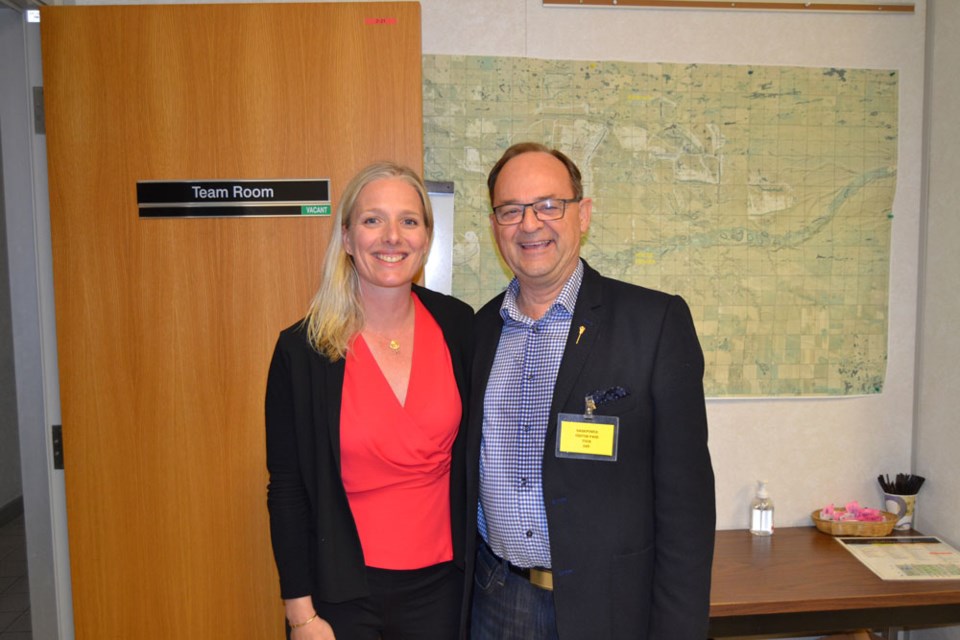Two ministers from the federal and provincial level who have very different jobs, but very similar mandates, met at the Boundary Dam power station on May 25 to talk about what Saskatchewan has been doing to meet environmental goals.
Catherine McKenna, Canadian minister of the environment and climate change, toured Boundary Dam, and its $1.5-billion Unit 3 carbon capture and sequestration (CCS) project, with Herb Cox, the Saskatchewan minister of the environment.
McKenna showed a great deal of enthusiasm for the technology in place at Unit 3, condoning the work that has been put into getting CCS up to snuff. This year, the carbon capture facility is approaching its 2016 goal of capturing 800,000 tonnes of carbon dioxide, which is the equivalent of taking 200,000 vehicles off the road for a year.
McKenna said that she came to Saskatchewan to find out what the province was doing on an environmental level.
“I want to understand how Saskatchewan is committed to tackling emissions and doing its part to address climate change,” said McKenna, during a brief media scrum after her tour of the facility. “It’s great to see first hand, and closeup. There are some amazing resources and amazing technology out here. It shows how dynamic this province is. We have some problem solvers here.”
McKenna said she was pleased to see the progress of the CCS technology at Boundary Dam, in light of the fact that coal is С����Ƶ used around the world, adding, “We need to find ways to reduce emissions from that use of coal. When you have carbon capture and storage, that’s certainly an innovative made-in-Canada solution, and a real opportunity for Canada to export.”
McKenna contended that there needs to be a variety of strategies to tackle the issue of climate change, and that the technology she was shown on the tour were part of that. She noted that she sees CCS technology as a separate piece of a bigger solution, from carbon pricing strategies.
“We had some discussions about (carbon pricing) here, and there are different approaches (for each province) that we’re going to need to take,” said McKenna. “It’s certainly great to see it in person, and it’s certainly part of what we need to do to reduce emissions.”
Cox said he believes that the CCS technology in place at Boundary Dam will serve not only as a Canadian, but a global solution, in the reduction of emissions. He added that the carbon capture has been recognized by international organizations such as the UN and International Energy Agency as a way to reduce greenhouse gas emissions from coal-fired generating stations.
“It was referenced in Paris in the UN secretary’s report; they highlighted what’s С����Ƶ done in Saskatchewan, here at Boundary Dam,” he said.
McKenna noted she had the opportunity to talk to people from the University of Saskatchewan and a number of businesses in the province, on what measures are С����Ƶ done to reduce emissions in the agricultural sector, as well.
“When you look at what’s going on, there’s some amazing research in terms of tillage and carbon sequestration,” said McKenna, “ There’s a lot of work С����Ƶ done to build more climate-resilient crops and reducing emissions from animals, by looking at animal feed. It was exciting.”
In addition to her tour of Boundary Dam, McKenna also learned more about energy in Saskatchewan by meeting with the First Nations Power Authority (FNPA), a First Nations governed not-for-profit development company reducing development costs and risks for First Nations-led projects. She noted the FNPA is working on a number of emission-reducing projects, including one by which they reduce the amount of methane released from oil and gas flaring.
“We’ve been having discussions on how we can support Saskatchewan, very generally. The province has a goal of getting to fifty per cent renewables, and that’s great to see,” said McKenna.
McKenna suggested that there are many potential opportunities that exist with the CCS technology, including working with other provinces to help reduce their emissions and further investment in the technology.
She added, “We want to support the action Saskatchewan takes, because we’re all in this together. That’s how we’re going to do a much better job at protecting our planet, and create good, clean jobs and opportunities for the next generation.”




